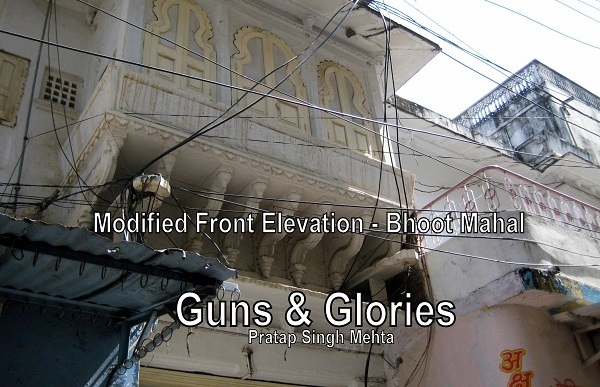Rain Water Harvesting…! I am talking about the haveli of #Bachhawat Mehtas, known as BHOOT MAHAL in Udaipur. Have you heard about it?
Late Ram Singhji Mehta disclosed to me the secrets of Bhoot Mahal (extracts from a video interview):
“In the main hall, there is a secret opening, under the carpet, to go to the basement, where there is ‘water tank’, toshakhana (treasure store), tehkhana (basement) and asalkhana (store for weapons). The two basement floors have not been visited by any person for over a century. It is said to be full of bats and presumably snakes too.”
He continues, “There are mud and lime pipes from terrace to the basement water tank, passing through the thick walls of the haveli. Perhaps, even three to four hundred years ago there was awareness about the need to conserve rain water. Today, we call it ‘rain water harvesting’. The walls of the haveli are 6 to 10 feet in thickness, very unusual for the construction of a haveli, even in those days”.
There are stories w ith regards to the origin of Bhoot Mahal. Kakasa, Mehta Ram Singhji and his wife Kakisa, Bhagwat Kanwar have narrated the following about Bhoot Mahal in a video interview in May 2004 to me.
ith regards to the origin of Bhoot Mahal. Kakasa, Mehta Ram Singhji and his wife Kakisa, Bhagwat Kanwar have narrated the following about Bhoot Mahal in a video interview in May 2004 to me.
 ith regards to the origin of Bhoot Mahal. Kakasa, Mehta Ram Singhji and his wife Kakisa, Bhagwat Kanwar have narrated the following about Bhoot Mahal in a video interview in May 2004 to me.
ith regards to the origin of Bhoot Mahal. Kakasa, Mehta Ram Singhji and his wife Kakisa, Bhagwat Kanwar have narrated the following about Bhoot Mahal in a video interview in May 2004 to me.Bhagwat Kanwar talks about a dant katha, “The practice of ‘Tantra-Mantra’ was quite prevalent during medieval period. The exact period being unknown, however, about 300-400 years ago the
re was a Rawat of Dhariyavad (धरियावाद), who was ordered by Maharana of Mewar to pay respects to him every week as a punishment for insubordination. Since he did not have residence in Udaipur, his whole week was spent in travelling up and down through forests and uncharted roads from Dhariyavad. One day while passing through the forest at night, he met a ghost (भूत) who was trying to harass him. It is said that if one can manage to catch the शिखा (mane) of a ghost, he then surrenders to his victim to fulfil his wishes and vows to work for him”.
re was a Rawat of Dhariyavad (धरियावाद), who was ordered by Maharana of Mewar to pay respects to him every week as a punishment for insubordination. Since he did not have residence in Udaipur, his whole week was spent in travelling up and down through forests and uncharted roads from Dhariyavad. One day while passing through the forest at night, he met a ghost (भूत) who was trying to harass him. It is said that if one can manage to catch the शिखा (mane) of a ghost, he then surrenders to his victim to fulfil his wishes and vows to work for him”.
Rawat managed to grab his ‘shikha’ (mane) after a prolonged struggle. The ghost surrendered and asked him, “What can I do for you Sir?”. Rawat asked him, “Who are you”? The ghost replied, “Khet Singh”. To which Rawat ordered, “Provide me a huge mansion (हवेली) at Udaipur, which will embarrass the King”.
Mehta Ram Singh continues, “It was at that time, a massive nine storey haveli was placed, overnight, on a small hillock between, present day Ghantaghar and Haati Pol (हाथी पोल) by Khet Singh. Maharana Ari Singh II observed this new structure in the city from his palace and felt uneasy as this haveli overlooked his palaces. He immediately ordered for demolition of top four floors. Since this mansion was biggest in size next to Maharana’s and those of Kanwarpada palaces and its origin unsure, it was referred to as ‘Bhoot Mahal’ (भूत महल). Hereafter, the Rawat of Dhariyavad was exempted from personal appearances at the Durbar.”
Since Mehta Agar Chand, then Pradhan (1764-99) did not have a proper residence in Udaipur, the Bhoot Mahal was granted to him. Mehta Ram Singhji and others who lived in Bhoot Mahal are all direct descendants of Mehta Agar Chand. Today, most portion of Bhoot Mahal have been sold off and modified.
